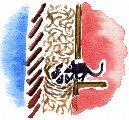
 |
Humidity buffering by porous, absorbent insulation |
Download the entire article (pdf 323Kb)
Thermal insulation made from wool will have a detectable, but small, moderating influence on variation in the indoor relative humidity in a house with less than half an air change per hour and with porous wall surfaces, such as paper, limewash or silicate paint. A vapour retarder on the room side of the insulation reduces the buffer action of the insulation to practical insignificance.
Water vapour distributes itself fairly evenly through a 160 mm layer of wool insulation during a 24 hour climatic cycle. But even if access of interior air is good, the RH buffering performance is limited by its low density and consequent low water capacity by volume.
Absorbent insulation will only have a useful influence on the indoor climate if the entire wall is redesigned to give a much more porous structure. This development would conflict with the custom of putting a vapour barrier or vapour retarder close to the inside surface of a wall. A more practical way of moderating the indoor relative humidity would be to use an absorbent interior finish instead of the customary gypsum board. The excellent performance of end grain wood as an interior finish is shown for comparison. One would also expect a wool tapestry to perform well.
The experiments reported here show the influence on the daily variation of indoor humidity of wool, vapour barrier and plasterboard, separately and combined into a wall. Paint is not included in the tests.
The response of a wall to a sudden injection of water vapour, as would happen in a kitchen or bathroom, is also studied. In this event the main moderator of the RH is the plaster board, while the wool insulation absorbs water slowly over a period of 60 hours. During such a long time, however, natural ventilation of a real room would already have moderated the RH. The contribution of the absorbent insulation is therefore only significant if the natural air exchange rate is very low. A low exchange rate is considered desirable to save energy but is also blamed for causing sickness because of the high indoor RH caused by human activities, which encourages microbiological growth. Any beneficial function of organic insulation must therefore lie in its ability to moderate the variation in RH within the wall while it releases moisture steadily to the outside to reduce the average indoor RH.
The risk of condensation within a porous wall without a vapour retarder is the subject of two experiments which are not completed at the time of writing. Only when these results are in, will the role of absorbent insulation be clarified sufficiently to justify full scale tests of porous, absorbent walls.
The article also includes a discussion of a suitable unit for describing the buffer performance of building materials and takes a critical look at the real meaning of the water vapour diffusion coefficient, when applied to porous insulation.

This work is licensed under a Creative Commons Attribution-Noncommercial-No Derivative Works 3.0 License.